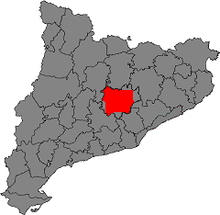Pla de Bages


Pla de Bages is a Spanish Denominación de Origen (DO) (Denominació d’Origen in Catalan) for wines, located in the province of Barcelona (Catalonia, Spain), and is one of the smallest DOs in Spain, covering only 600 hectares. It is also one of the newest having acquired its official status in 1995.[1]
History
In wine-making contexts the name of Bages is often said to derive from an otherwise unnoted ancient Roman city of Bacassis located in the area. According to an unidentified mediaeval document from the former Benedictine monastery of Sant Benet, the Roman city was named in honour of Bacchus, the Roman god of wine.
Production in the area was interrupted for almost a century after the outbreak of the phylloxera plague at the end of the 19th century.
Geography
The vineyards are mainly located in the valleys of the Llobregat and its tributaries.
Soils
There are two different types of soil in two well-defined topographies: a central basin (Pla de Bages) with clay and marl soils at an altitude of 200 m above sea level; and a peripheral area (Alt Bages, "Upper Bages") where marl and lime bearing soils with a high carbonate content abound, at an altitude of 500 m above sea level.
Climate
The climate is Mediterranean with strong continental influences due to its inland location quite far from the sea. Humidity is lower, summers hotter and winters colder than in other wine-producing areas in Catalonia. The average annual temperature is 13°C (max 35°C in summer, -5°C in winter) and there are considerable temperature variations between day and night as well. Average annual rainfall is between 500 mm and 600 mm.
Grape varieties
The traditional local grape varieties are Grenache (here called Garnatxa) and Tempranillo (known locally as Ull de Llebre) for reds and Picapoll for whites, while the new authorised foreign varieties are: Macabeo, Parellada and Chardonnay for whites, and Cabernet Sauvignon, Merlot and Syrah for reds.
The newer vineyards are planted on trellises (en espaldera) to allow mechanisation of the vineyard activities, at authorised planting densities of between 2,000 and 4,500 vines/ha depending on the terrain. Most of the grape production is for the white or pink sparkling wines called Cava.
See also
References
- ↑ https://www.gencat.net/diari/4585/06045133.htm DO Regulations, published in DOGC no. 4585 dated 3-3-2006. In Catalan
External links
Coordinates: 41°43′14″N 1°50′23″E / 41.72056°N 1.83972°E